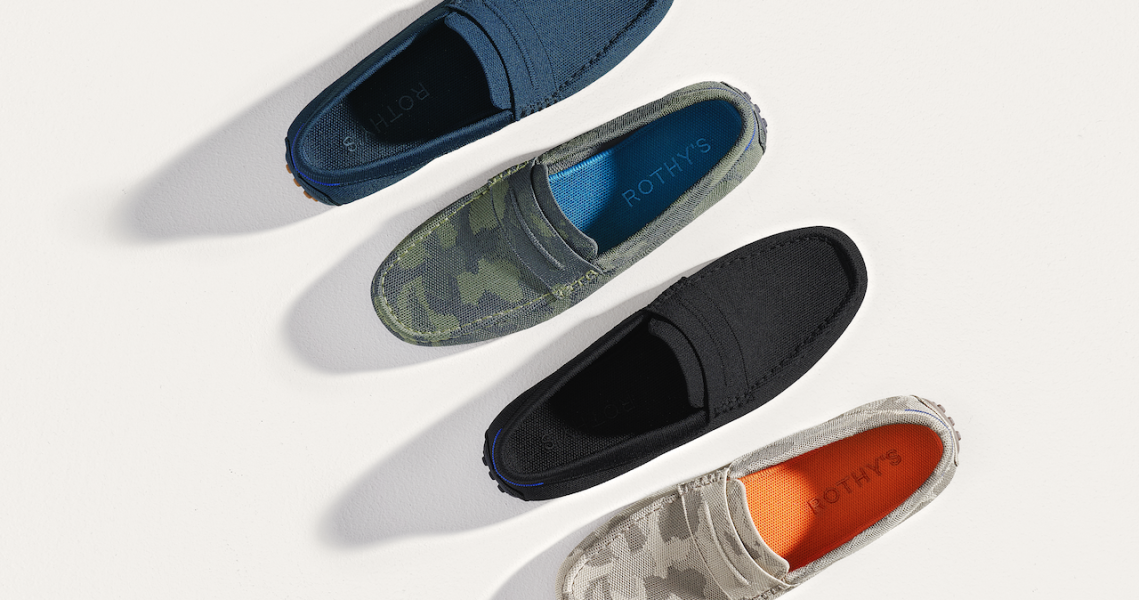Rothy’s has had years to establish itself in the women’s footwear business, but new svp Chris Hull, who quietly joined the company in October, is spearheading the brand’s launch into an entirely new category: men’s sneakers.
Launching on Thursday, the men’s category will start with two models — a sneaker and a loafer — in four classic colorways, like white-on-white. They’ll be sold online and at the brand’s six U.S. stores. The goal was to keep the first iteration of the product simple, to act as a strong base from which the rest of the men’s category can flourish. Hull said the team first began brainstorming how they would dive into men’s in 2018, before he joined the company. The intention is to grow men’s into 50% of the company’s revenue over the next few years.
“This is going to be a major brand pillar for us,” Hull said. “It’s a major milestone. So you can expect it to be as high as women’s. Obviously, women’s has had a headstart, but this is going to be a meaningful business for us.”
Hull had previously spent five years at Nike, five at Converse and four at Shinola. His experience gives him a keen insight into the modern male consumer, he said. Compared to women, men haven’t typically been as moved by sustainability marketing in the past, he said. But that’s changing, especially as brands like Nike and Patagonia, with large male audiences, are starting to bring resale and sustainability into their messaging.
Marketing to a new audience and growing the category will be tough, Hull said. Initial marketing efforts for men’s will focus on leveraging Rothy’s existing female customers. Emails have gone out to Rothy’s female customer base, suggesting they buy the new men’s product for the men in their lives or introduce them to the brand verbally. The latter is a proven marketing method for the brand. CEO Stephen Hawthornthwaite said that 50% of traffic to Rothy’s website is direct and over 50% of customers purchase Rothy’s after hearing a recommendation from friends or family.
The brand is targeting men of all ages, but Hull said the company’s largest customer base is people in their 30s. The product has already been sent out to influencers like Nick Wooster (830,000 Instagram followers) and Brad Goreski (750,000 followers).
Hull declined to share specific marketing budget figures, but he said Rothy’s has been flexible and open to trying new things to build the men’s audience. It’s a new world for the brand and some experimentation will be necessary, he said.
“We’ve done research on what platforms are appealing to men, so you might see us advertising men’s through other places like Twitter,” Hull said. “But we don’t know what we don’t know. I’m really grateful to the team that they’ve given me the resources to try things out and see what resonates.”
The move to men’s comes at a time of strength for Rothy’s, which added 450,000 new customers last year, bringing the total customer count to 2 million. That’s despite that it reduced advertising spend by an undisclosed amount. Hawthornthwaite said 40% of the brand’s customers own more than one pair of Rothy’s shoes and 10% own more than five pairs. That continued growth gave them the confidence to pursue men’s, he said.
Some of Rothy’s peers have also had similar ideas to invest in sneakers and men’s. La Ligne, a DTC women’s brand at around the same price point as Rothy’s, also just launched men’s apparel last week. And French women’s fashion brand Ba&sh just launched into sneakers for the first time in March.
“Men’s has consistently been our most-requested category, and we see huge potential for its growth — on a comparable trajectory to our women’s business,” Hawthornthwaite said. “We see incredible value in bringing Rothy’s to the men in these customers’ lives, as well as an entirely new community of men who are about to meet Rothy’s for the very first time.”




